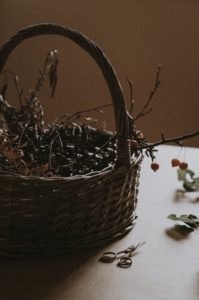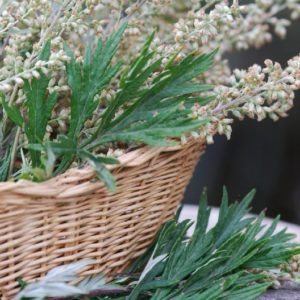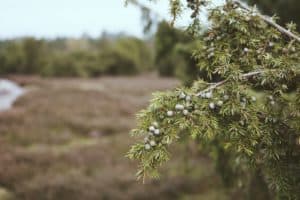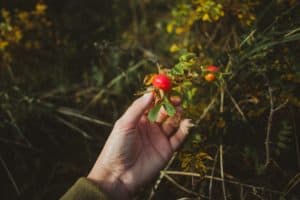Fall is an exciting time for Nordic herbs. Foraging has been a long-loved Nordic activity, especially in September, when everything is brimming for harvest and the long dark winter fast approaches. As a Swedish folk magic practitioner, I tramp into the forest every year to find a bounty.

In terms of foraging, I am a little more pedestrian in my practice. I really admire adventurous mushroom foragers who spend days in the woods. The closest I’ve come to that was berry picking in mid-July on the side of a mountain, but that was a rare treat.
Here are a few favorites of mine that can be easily found in the Northeast and have folk roots with the people of Sweden, Finland, Norway and Denmark.

Mugwort
In Maine, where I spend most of the year, mugwort (Artemesia vulgaris) is considered an invasive species. This makes the art of foraging this useful weed all the more satisfying.
Seasoned foragers are aware of the typical etiquette that accompanies foraging practice; you should never take more than a small percentage of what you forage, so that the plants have an opportunity to regrow. Not so, with mugwort! You don’t really even have to leave the beaten path, it grows along the roadside (although I would venture a little ways from the road if you plan to burn or ingest it.)
The Nordic people had their own unique relationship with mugwort. Some entomologists are of the opinion that the common name for the plant is in fact derived from the old Norse word muggi- meaning marsh and Germanic wuertz meaning root. Mugwort was a staple for the völur, the Norse prophecy women who inhabited the pre-Christian era. This is no surprise, considering that an important part of their magic related to dream travel. Mugwort was regarded as an important herb for dream spå, or prophecy, but Nordic magic practitioners, as it was believed to aid in the spirit traveling out of the body. Mugwort was also burned as a tool of spiritual cleansing, and is used by witches regularly.
In my own work, I will often turn to mugwort as a lucid dreaming aid. In August performed a study in which I used a mugwort oil anointment and drank mugwort tea before going to bed. While I can’t be sure if my spirit actually left my body, there was a significant increase in the vibrancy and narrative of my dreams, and it gave me a nice look into my subconscious life.

Juniper
Juniper is among my favorite wild forgeables, as I’ve mentioned in a previous blog article. The berries are typically really easy access, and Juniperus communis, which is native to Maine, can be found pretty abundantly. If you’re in doubt, you can just crush one of the berries in between your fingers, and you will get a big whiff of that signature juniper smell. Those same berries you can take home and dry, substituting them for store-bought juniper.
While most people just forage for the berries, I really prefer juniper for its branches and needles. There is more writing about this in Scottish magical traditions, but juniper was a useful cleansing tool when bundled and burned. This was often the smoke clearing method of choice in the springtime. Given the endangered nature of palo santo and white sage – and being a roots practitioner who believes wholeheartedly one should not use the tools of closed traditions without invitation – I try to keep my clearing practices as close to my own personal family of origin practice as possible.
Juniper was most certainly used by my ancestors, and you can find a fair amount of documentation in Trolldom, or the folk magic tradition of Sweden, Denmark, and Norway, of various uses for juniper. They would use juniper ash, oil, berries, and branches for heavy periods to removing curses from shotguns. Juniper certainly is versatile!

Rosehips
Rosehips are not strictly an herb we see in Nordic texts, but they were available to the Nordic people and they are lovely. I am a low maintenance forager, and I’m always a fan of foraging. Rosehips are easy to spot, straightforward to gather, and fill one with a sense of abundance.
Rosehips can be used for so many things – the first that comes to mind is tea. In Sweden there is a really lovely dish called Nyponsoppa, or Rosehip Soup. They pick the rosehips after the first frost of fall, once they are ripe and red. Then they are dried out. The rosehips are boiled, blended, and strained, and the whole thing is thickened with starch. Also, being a Swedish dish, of course they add sugar and throw in some little round cookies. It’s not hard to see the benefit of this treat in the late fall and early winter. Rosehips are notoriously high in vitamin C, which is absolutely the best.
Here is my own little recipe for Nyponsoppa!
- 4 cups of dried rosehips (if you use fresh, reduce the water by 1 1/2 cups)
- 4 ½ cups tepid water
- 5 green cardamom pods lightly crushed
- 1 cinnamon stick
- A sliver of fresh ginger
- ¾ – 1 teaspoon arrowroot powder (optional)
- Lemon juice to taste
- Honey to taste
Add rosehips and spices to stockpot. Bring to a boil. Let simmer for 3-5 minutes. Then remove from heat. Let rosehips steep in the hot water for 1 hour.
Working in batches, whiz in a blender. You do not need to make a smooth puree. Strain the pureed liquid, a nut milk bag works well. Return to pot. Bring to a low heat and slowly introduce just enough arrowroot to thicken it. Add honey and lemon to taste.
Serve warm with almond cookies.
Best Way to Forage for Herbs
In terms of best practices, I always follow the rule of leaving an area with enough forgeable goods left for regrowth and renewal. This is thoughtful for other foragers, nature spirits and animals, as well as the longevity of the plant itself.
It is also very important in my own personal practice to ask the permission of the plants and forest. I believe that we have a responsibility to nature to show up with respect and honor, like visiting a favorite grandmother. If at any time I get a bad feeling, I stop foraging.
All of these forgeable plants are either sustainable, in that they won’t decimate the population if you forage responsibly. Or they are helpful to the environment because they are invasive species. Either way I hope this gives you a well-deserved excuse to pop into nature!
P.S. Do not forage anything you’re not 100% sure you are identifying correctly. You do not want to forage the wrong thing and make yourself sick. Always use a guide or find a knowledgeable friend.
Citations:







